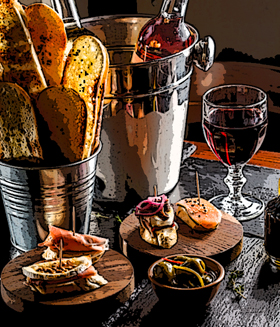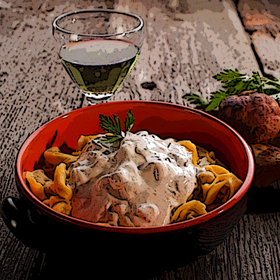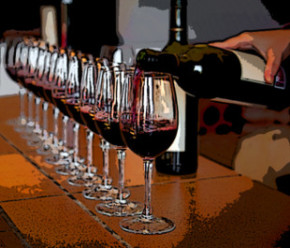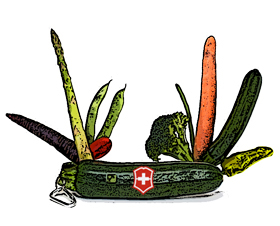The Salt Conundrum In Food & Wine Pairing.
Chapter Nine, Part Eight.
 When pairing food with wine, sweet and sour tastes fall neatly into the cancellation category, bitter and piquant are subject to the cumulative effect, and umami is best grouped with neutral pairings, but what about salt? In moderation, salt doesn’t seem to have any conspicuous consequence, but how does excessive saltiness in food affect the taste of wine? To learn how (or if) salt fits into the A. cancellation, B. cumulative or C. neutral categories, I invited some friends over for some organoleptic research. They quickly declined until I told them that meant we were going to eat and drink wine.
When pairing food with wine, sweet and sour tastes fall neatly into the cancellation category, bitter and piquant are subject to the cumulative effect, and umami is best grouped with neutral pairings, but what about salt? In moderation, salt doesn’t seem to have any conspicuous consequence, but how does excessive saltiness in food affect the taste of wine? To learn how (or if) salt fits into the A. cancellation, B. cumulative or C. neutral categories, I invited some friends over for some organoleptic research. They quickly declined until I told them that meant we were going to eat and drink wine.
Good old fashioned research is difficult and time consuming but in the name of conscientious reporting the WASTED team (Wine Snark Academy for Sensory Testing, Evaluation & Debauchery) created a salty feast and drank five bottles of wine because that’s the kind sacrifice we’re willing to make in the name of, umm … science, yeah that’s it, science.
Read MoreThe Neutral Effect In Food and Wine Pairing.
The impact of the chemical reactions taking place in your mouth when you combine food and wine can be very obvious when you’re experiencing the cancellation effect or the cumulative effect, but there’s another interaction between food and wine that’s just as rewarding, but much less pronounced. I call this subtle interplay the neutral effect. I realize that describing a food and wine pairing as neutral sounds sort of, well … neutral, but that doesn’t mean these combinations are boring. Neutral pairings occur when similar flavors come together in a safe, reassuring place, sort of like Switzerland.
Read MoreThe Cumulative Effect In Food And Wine Pairing.
Chapter Nine, Part Six.
 When pairing food with wine the cancellation effect works to your advantage once you understand how to balance the taste or texture of sweet and acidic food with similar traits in wine. While acidity and sweetness cancel each other out when combined on your palate, bitter and piquant sensations accumulate and magnify one another. The same can be said for pairing low acid foods with low acid wines so I’ll go ahead and say it; creamy or fatty traits do not cancel each other out; they accumulate on your palate (and also on your waistline). So after many years of deliberation I’ve decided to call this the cumulative effect.
When pairing food with wine the cancellation effect works to your advantage once you understand how to balance the taste or texture of sweet and acidic food with similar traits in wine. While acidity and sweetness cancel each other out when combined on your palate, bitter and piquant sensations accumulate and magnify one another. The same can be said for pairing low acid foods with low acid wines so I’ll go ahead and say it; creamy or fatty traits do not cancel each other out; they accumulate on your palate (and also on your waistline). So after many years of deliberation I’ve decided to call this the cumulative effect.
The Wine Tasting Stream of Consciousness.
Chapter Four. Part Three.
 It’s wine tasting season in New York once again. A season-ending injury kept me out of the fall tasting line-up and at the first spring event I started slurring my speech, dropped several wine glasses and fell down twice. I became disoriented, dizzy and incoherent so I did the only sensible thing.
It’s wine tasting season in New York once again. A season-ending injury kept me out of the fall tasting line-up and at the first spring event I started slurring my speech, dropped several wine glasses and fell down twice. I became disoriented, dizzy and incoherent so I did the only sensible thing.
I drove myself straight home.
Years ago, when I first started attending wine tastings, I developed an olfactory/gustatory associative process to try to pinpoint the flavors and aromas that seemed so familiar yet so elusive. The first time I recognized the taste of vanilla in a red wine is a good illustration of how this free flowing stream of consciousness unfolds.
Read MoreQuality Hangs In The Balance.
Chapter Three. Part Three.
 To enjoy a great symphony or painting you needn’t analyze each note or brushstroke; you should embrace the emotional impact of the whole piece. It’s up to the snobby enthusiasts, historians and critics to pick apart the elements behind the artwork and ruin it for the rest of us. Hey, somebody’s gotta do it.
To enjoy a great symphony or painting you needn’t analyze each note or brushstroke; you should embrace the emotional impact of the whole piece. It’s up to the snobby enthusiasts, historians and critics to pick apart the elements behind the artwork and ruin it for the rest of us. Hey, somebody’s gotta do it.
Wine is much like music and art in that it is best appreciated when approached holistically. Unless of course, you’re one of those wine aficionados that spends all day in wine chat rooms when you’re supposed to be watching the kids. In that case you’re going to pay close attention to the individual elements inherent in wine so that, much like a music or art critic, you can bore your friends into a catatonic stupor with your insightful analysis. Thank God I’m here to help.
Let’s face it. When it comes to wine you’d probably like to be more like me – except that you’d want to bathe more often and
Read More




















